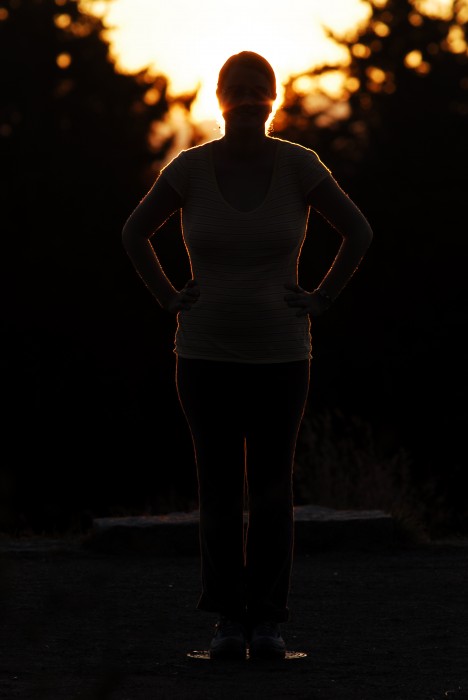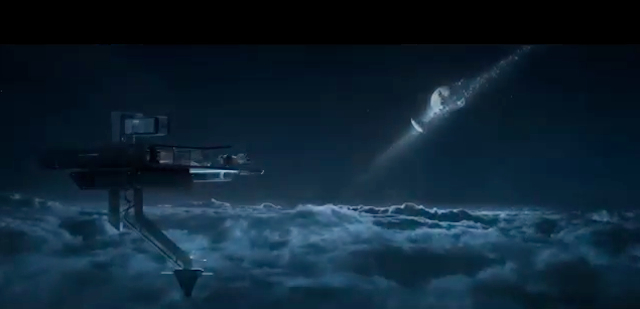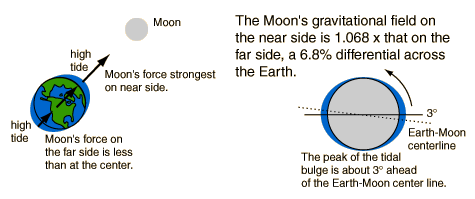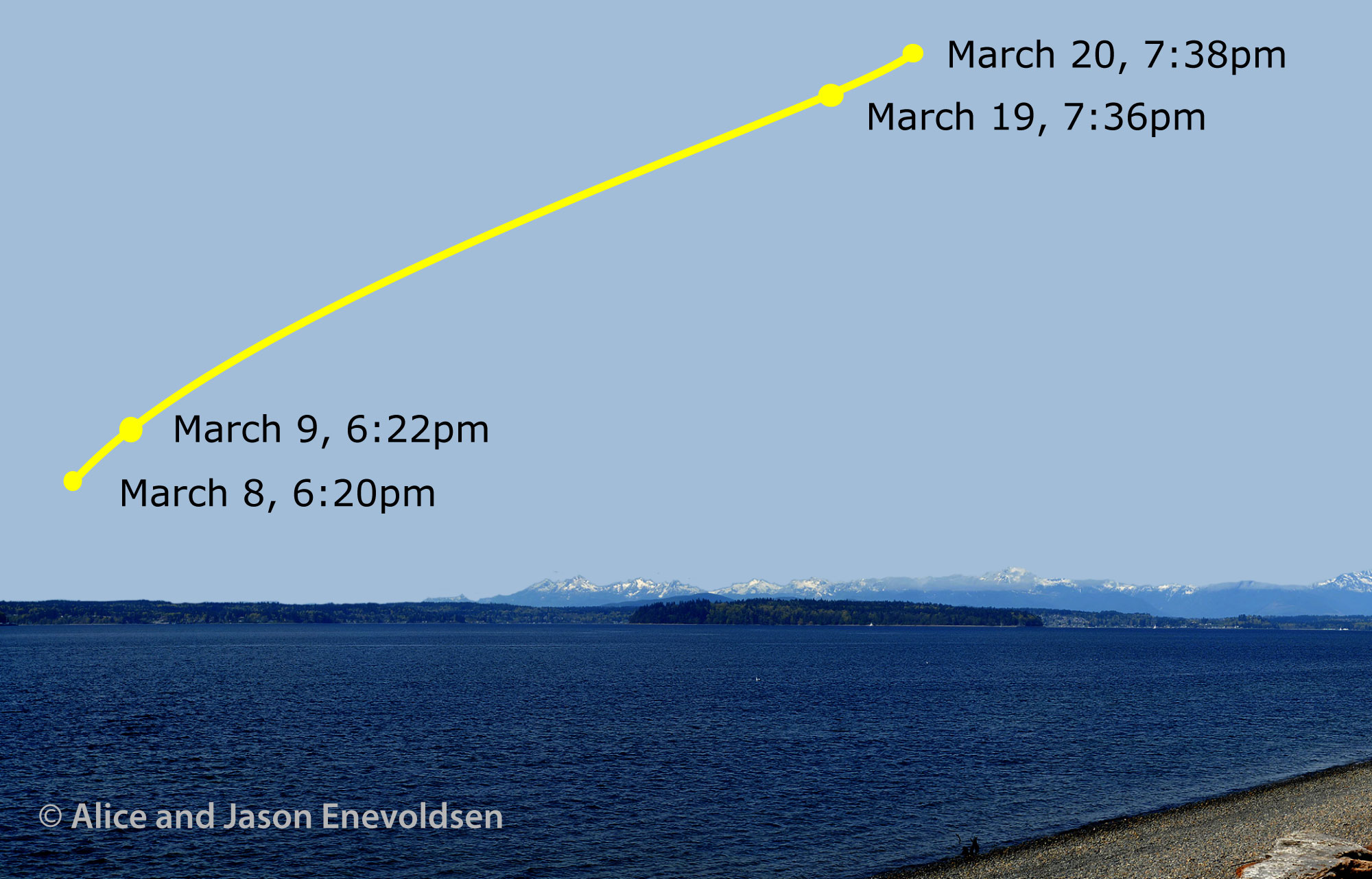 Summer Solstice Sunset Watch – 2013
Summer Solstice Sunset Watch – 2013
It’s time for the 17th seasonal sunset watch!!
- When: Thursday, June 20 at 9:00pm (so come at 8:45pm)
- Actual sunset is supposed to be at 9:11pm, but at the last summer solstice we noticed that the Sun set about 10 minutes earlier than the USNO says it does, so I’ve moved the time of our sunset watch up so we don’t miss it. Last autumn the timing seemed to line up correctly – what will it do this time?
- The equinox moment is at 10:04pm… but we’re watching the sunset not the sunrise because of how the park lines up.
- Where: Solstice Park – all the way up the hill from the tennis courts (or, if you’re not in Seattle, wherever you have a view of the western horizon!)
- Who: Everyone welcome, as usual.
Come watch the winter solstice sunset at Solstice Park in West Seattle on Saturday the 22nd. We’ll see if the sunset lines up with the placed marker. I’ll be there even if it is cloudy because sometimes the Sun peeks through just as it begins to set, but if it is driving rain or sleet I’m staying home with some hot tea!
If you’re interested – here’s the timing of various celestial events from Seattle, courtesy of the U.S. Naval Observatory Astronomical Applications Department:
Sun and Moon Data for One Day
The following information is provided for Seattle, King County, Washington (longitude W122.3, latitude N47.6):
Thursday 20 June 2013 Pacific Daylight Time
SUN Begin civil twilight 4:30 a.m. Sunrise 5:11 a.m. Sun transit 1:11 p.m. Sunset 9:11 p.m. End civil twilight 9:52 p.m.
MOON Moonrise 4:58 p.m. on preceding day Moonset 2:51 a.m. Moonrise 6:11 p.m. Moon transit 10:57 p.m. Moonset 3:38 a.m. on following day
Phase of the Moon on 20 June: waxing gibbous with 89% of the Moon’s visible disk illuminated.
Full Moon on 23 June 2013 at 4:33 a.m. Pacific Daylight Time.
This event is my part of the NASA’s Solar System Ambassador program, and thanks to West Seattle Blog for publicizing the last few!
Everyone is welcome, see you there!
![]()
~ A l i c e !
 What If We Had No Moon? (Oblivion Spoilers)
What If We Had No Moon? (Oblivion Spoilers)
I was alerted last week to the possibility that people might be asking questions about the scientific possibilities suggested in the movie Oblivion, released today. May I point out that ripping apart the science in movies like this is a form of entertainment for me? If you aren’t interested, go read someone else’s blog.
Shameless plug: You should go see Oblivion at Pacific Science Center in IMAX.
In order to address these issues, I have to talk about the movie, but I’m going to do my best not to spoil the whole thing since you might want to see it.
SPOILER ALERT
.
.
.
SPOILER ALERT
.
.
.
SPOLIER ALERT
.
.
.
In Oblivion the year is 2077, and the Moon has been destroyed by robot aliens. This caused widespread destruction due to earthquakes and tsunamis. The tectonic activity has stabilized, but humanity has migrated to Titan. A few people are still on earth guarding the Hydro Rigs that convert seawater into energy for the Titan colony. The Moon is depicted as being half there, half a debris ring around the Earth.
Meteorites
Yes, and the movies doesn’t have any.
The method of the Moon’s destruction isn’t dwelled upon in the movie, but I get the impression it was a nuclear war. Let’s just assume the alien race has enough power to blow up the Moon, and they do so.
The first effect is going to be a huge number of meteorites slamming into the Earth. These aren’t going to be just a few that make some pretty craters, that’s a lot of mass up there in the Moon and a lot of it is going to come raining down on the Earth. I think this is going to be the most devastating effect. I’ll have to run some hypothetical math (or maybe Phil Plait or XKCD What-If will do it before me), but it seems like this rain of debris would be significantly more destructive than the meteor that probably killed off the dinosaurs. There will be more mass than that single meteor (a LOT more mass), and it will rain down over more of the planet. I suspect it will be moving more slowly though, so that may mitigate the effect a bit.
Last I heard the dinos died out either because of the ensuing nuclear winter (too much ash and dust in the atmosphere, cooling the climate) or a nearly instantaneous ignition/superheating of most of our atmosphere, which would have broiled everything aboveground leaving burrowing animals and sea-life alone. Whoo-ee. Someone check my references on that. (Jonas? Jonas? Why are you in New Zealand when I need you?). So, the Moon debris falling down would be very bad.
But somehow no meteorites from the lunar explosion.
Earthquakes
Sure. There could be earthquakes if the Moon blew up. Mostly due to IMPACTS FROM METEORITES. Barring those I’m having trouble envisioning why we would get earthquakes from the Moon breaking up in orbit. So my answer is:
Not the way they are in the movie.
The Moon does pull tidally on the Earth’s crust a little bit, but the effects are not the kind that we generally notice over the span of human lifetimes. Even by spreading out the mass of the Moon into more of a ring, you’ll also lose that tidal flex. I would expect that to make fewer earthquakes, not more. In the process of the Earth settling from a shape influenced by the Moon into a shape influenced by the debris ring we will have some earthquakes, but not ones that destroy cities.
If we were Jupiter’s moon Io, and it was Jupiter that was destroyed then yes, we would feel significant tectonic stress. But we’re not.
The Moon’s tidal forces do assist in keeping the Earth’s crust heated, and possibly impact the fact that we have moving tectonic plates in the first place. Now that tectonic plates have formed though, it will take a bajillion years to slow them down and stop them.
Tsunamis
Let’s say yes.
We all know the Moon is the major influencer on our tides here on Earth. The Moon and the Sun share the duties of causing the Earth’s tides, but the Moon does 2/3 of the work, and the Sun only does the leftover 1/3. So there’s a lot of water caught up in the tidal oval at any given time. The Earth rotates through that oval of influence, giving us two high tides per day.
Here’s a diagram of the tidal oval. It’s exaggerated a lot:
From: http://hyperphysics.phy-astr.gsu.edu/hbase/tide.html#stid
That’s a LOT of water to displace, and most of it is at the equator. So if the Moon suddenly disappears, that peak will slosh back down and (after sloshing back and forth a lot) will settle into a more even distribution. With half the Moon still in place, we’ll only be redistributing about 1/3 of that water. Also, since the Moon’s debris is staying in orbit (forming a ring), we won’t need to displace the water towards the poles, it can stay concentrated near the equator. Even though that is a significant reduction, it’s still a lot of moving water, suddenly. That’s a tsunami: a LOT of ocean water being displaced suddenly.
A caveat: it looks in the movie as if those tsunamis carried a lot of sediment with them, enough to cover all but the very top of the Empire State Building. Tsunamis from the destruction of the Moon would have no reason to dredge up sediment from the bottom of the ocean, so I don’t know where it is implied that material came from. I have no problem with the water washing that high in a significant Moon event, but not mud or sand.
A Ring around the Earth
When you first see the movie you’ll say “Alice! That ring is around the Moon, not the Earth.” Just wait, later on it becomes visible as a ring around the Earth.
Yes and no.
I guess that’s my answer for all of these. This is the case where I need to pull out my solar system dynamics textbooks and run through some equations first though.
Yes: soon after the destruction of the Moon, any debris will end up in orbit, and a lot of that will be leading or following the Moon’s own orbit, since that’s where it originated. This will give us a lumpy ring. It won’t be as bright as in the movie, because it will be mostly dust and boulders. Saturn’s ring is very visible because it is mostly very reflective ice. Dust is darker.
Over 60 years (from the Moon’s destruction around 2017 or later until the time of the movie in 2077), some of that debris will have reentered the Earth’s atmosphere, and the rest will also still be orbiting in that ring.
Over a more extended period of time I don’t think the distance of the Moon’s orbit is a stable place for a ring system. The dust will either recoalesce into one or a few Moons, drift to a different orbit, or fall down to the Earth.
I haven’t had time to sit down and calculate any of this out, but these are my reasonably-well-educated guesses.
References
If We Had No Moon, Bernard Foing http://www.astrobio.net/index.php?option=com_retrospection&task=detail&id=2507
Sun’s Tidal Effect http://hyperphysics.phy-astr.gsu.edu/hbase/tide.html#stid
365 Days of Astronomy http://cosmoquest.org/blog/365daysofastronomy/2009/03/28/march-28th/
NASA http://helios.gsfc.nasa.gov/qa_earth.html#quake
.
.
.
SPOILER ALERT
.
.
.
SPOILER ALERT
.
.
.
SPOLIER ALERT
![]()
~ A l i c e !
 Where is Comet PanSTARRS? (Estimating the Sky in Degrees)
Where is Comet PanSTARRS? (Estimating the Sky in Degrees)
**This is an old post I thought you’d like.**
Okay. So. You’re trying to find the comet. This is a basic primer on how to estimate where things are in the sky without stars to help you.
Estimating Degrees on the Sky
Use Your Hands
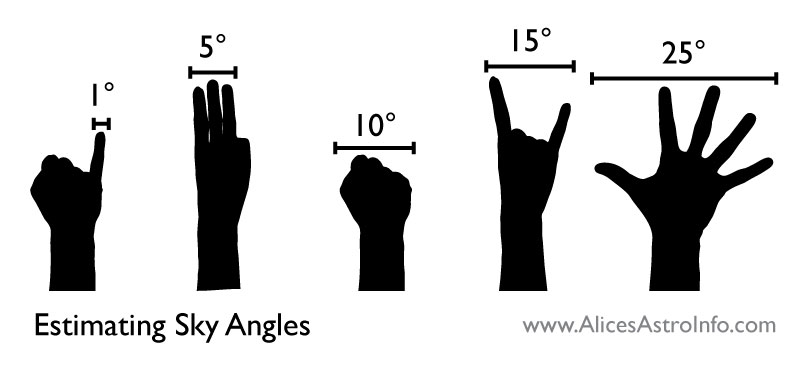
Hold your hand at arms’ length. This works for any size hands assuming you are close to average human proportions, but only if you completely extend your arm.
Actually, this graphic pretty much says it all.
Your fist at arms’ length is about ten degrees wide. Your pinkie finger is one or one and a half.
Know Where You Are and What You Can See
The rest of this article is specific to finding the comet from near Seattle. If you’d like to find it in another location, you’ll need to know exactly where due West is, and the altitude (height) and aziumuth (direction, 270 degrees is due West, and north of West is larger numbers) of the comet for the specific day and time of observation. Try Sky & Telescope for observing data.
Believe it or not, we’ve had good luck seeing this cute little comet from Seattle, between the clouds. You’ll need binoculars.
From the point of Lincoln Park you can easily see Blake Island. It’s the dark one north of Vashon. The South end of Blake Island is at 269°–almost due West (270°). The North end of Blake Island is 15° (the distance of your pointer to your pinkie) towards North, at 284°.
From Alki Point (the one with the lighthouse, not the one with the Statue of Liberty) due West (again, 270°) is the South end of Bainbridge Island.
From the far south side of West Seattle: Arbor Heights, 270° is the North end of Vashon Island.
You can figure this out for yourself pretty quick with a Puget Sound map of your choice. Pinpoint your viewing location and what visible marker on a nearby island or the peninsula is exactly West from you?
Height
To determine how many degrees up into the sky something is, you’re measuring from the perfectly flat horizon. Using the far edge of the water of Puget Sound is a great estimate for this.
Finding the Comet (from Seattle)
Comet becomes visible in binoculars about half an hour after sunset. Forty-five minutes after sunset you might see it with just your eyes.
Monday, March 18, 2013 — Sunset: 7:20pm
- 7:50pm at 280° (one fist North of due West)
13° up (A little less than your pinkie-to-index finger distance).
- 8:25pm at 286° (your pinkie-to-index finger distance North of due West)
7.5° up (between the height of your fist and the height of three fingers)
- 9:00pm at 292° (not quite your full-spread hand North of due West)
2° up (a bit more than your pinkie-width)
Tuesday, March 19, 2013 — Sunset: 7:22pm
- 7:52pm at 282° (between a fist and your pinkie-to-index finger distance North of due West)
13.5° up (A little less than your pinkie-to-index finger distance).
- 8:29pm at 288° (your pinkie-to-index finger distance North of due West)
7.5° up (between the height of your fist and the height of three fingers)
- 9:06pm at 295° (Your full-spread hand North of due West)
2° up (a bit more than your pinkie-width)
Wednesday, March 20, 2013 — Sunset: 7:23pm (Come to the Sunset Watch!)
- 7:53pm at 284.5° (between a fist and your pinkie-to-index finger distance North of due West)
14° up (A little less than your pinkie-to-index finger distance).
- 8:32pm at 291° (Almost your full-spread hand North of due West)
8° up (between the height of your fist and the height of three fingers)
- 9:11pm at 298° (Your full-spread hand plus three fingers North of due West)
2° up (a bit more than your pinkie-width)
Thursday, March 21, 2013 — Sunset: 7:25pm
- 7:55pm at 286.5° (Your pinkie-to-index finger distance North of due West)
14.5° up (Your pinkie-to-index finger distance).
- 8:36pm at 294° (Your full-spread hand North of due West)
8° up (between the height of your fist and the height of three fingers)
- 9:17pm at 301° (Your full-spread hand plus three fingers North of due West)
2° up (a bit more than your pinkie-width)
Friday, March 22, 2013 — Sunset: 7:26pm
- 7:56pm at 289° (Between your pinkie-to-index finger and your full-spread hand distance North of due West)
15° up (Your pinkie-to-index finger distance).
- 8:39pm at 296° (Your full-spread hand North of due West)
8° up (between the height of your fist and the height of three fingers)
- 9:22pm at 304° (Your full-spread hand plus your fist North of due West)
2° up (a bit more than your pinkie-width)
Saturday, March 23, 2013 — Sunset: 7:28pm
- 7:58pm at 291° (Between your pinkie-to-index finger and your full-spread hand distance North of due West)
15° up (Your pinkie-to-index finger distance).
- 8:43pm at 299° (Your full-spread hand plus your fist North of due West)
8° up (between the height of your fist and the height of three fingers)
- 9:27pm at 306.5° (Your full-spread hand plus your pinkie-to-index finger distance North of due West)
2° up (a bit more than your pinkie-width)
Sunday, March 24, 2013 — Sunset: 7:29pm
- 7:59pm at 293° (Your full-spread hand distance North of due West)
15.5° up (Your pinkie-to-index finger distance).
- 8:46pm at 301° (Your full-spread hand plus your fist North of due West)
8.5° up (between the height of your fist and the height of three fingers)
- 9:33pm at 309.5° (Your full-spread hand plus your pinkie-to-index finger distance North of due West)
2° up (a bit more than your pinkie-width)
Basics
I made this graphic for West Seattle Blog. It’ll help you in a general sense, but not on a daily basis.
Want More?
One Minute Astronomer also has a good general write-up about estimating the sky. It is more detailed than mine, more general than mine, and outlines the basics that most amateur astronomers use every night.
I also want to give credit where credit is due. I used hand images, with permission, from all-silhouettes.com. I modified them significantly to suit my purpose. Stanislav makes cool images, but the website is full of links to spam and malware.
![]()
~ A l i c e !
 Photo of Comet PanSTARRS from West Seattle: Through the Clouds
Photo of Comet PanSTARRS from West Seattle: Through the Clouds
I will add more later, but here is the first photo my husband got of Comet PanSTARRS from Lincoln Park here in West Seattle. It was visible between the clouds for about three minutes.
Update, new image!
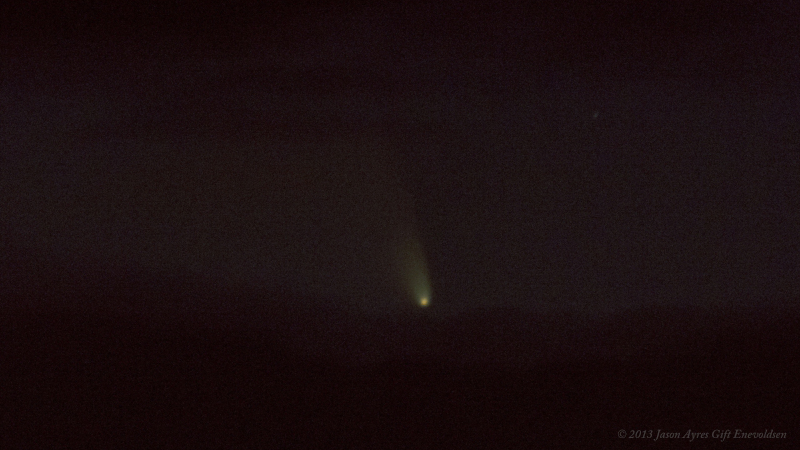
Comet PanSTARRS from West Seattle at 8:32pm on Friday 3/15/2013 (c) my husband Jason Ayres Gift Enevoldsen. E-mail him at jason dot enevoldsen at gmail dot com for reuse permission. Click for bigger. (This is the second, updated image. Below is the first)
This is the original image I posted this evening:
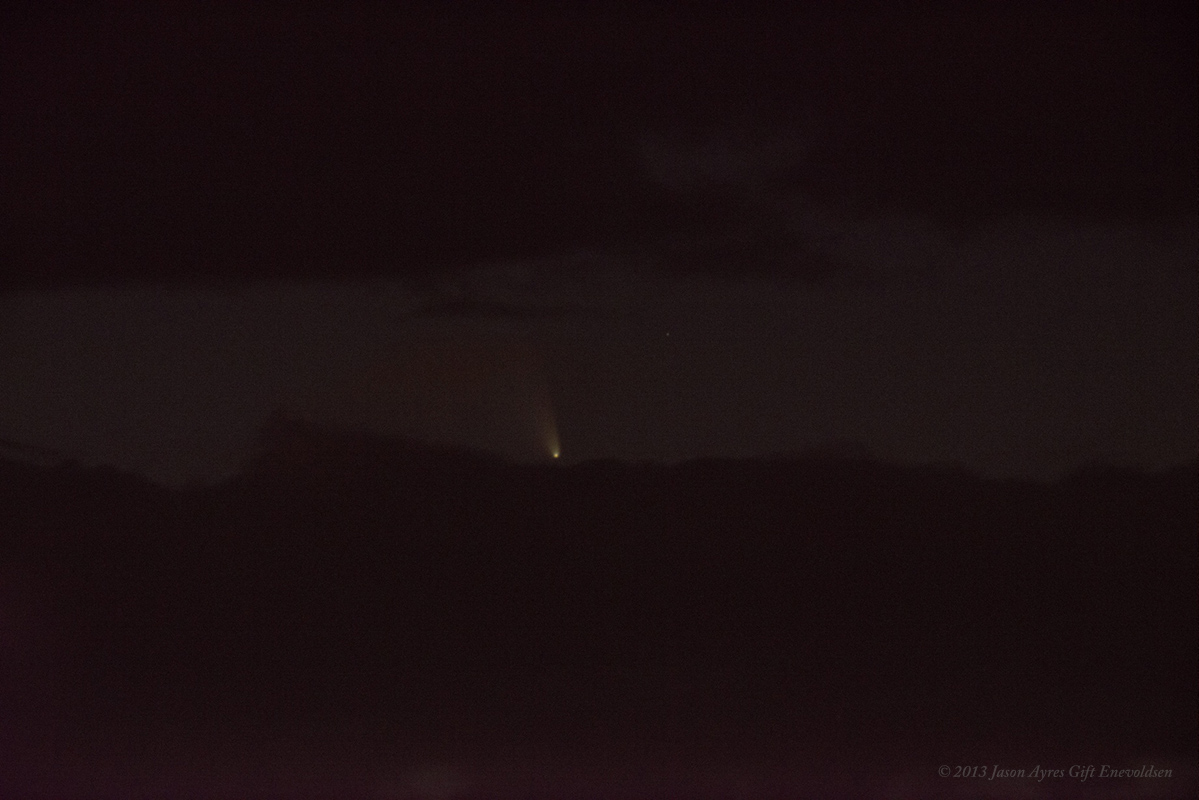
Comet PanSTARRS from West Seattle at 8:32pm on Friday 3/15/2013 (c) my husband Jason Ayres Gift Enevoldsen. E-mail him at jason dot enevoldsen at gmail dot com for reuse permission. Click for bigger
![]()
~ A l i c e !
 Spring Equinox Sunset Watch — 2013
Spring Equinox Sunset Watch — 2013
Is the Sunset Watch going on, even with this weather? Yes.
- In case of pouring rain or lightning storm, this event will be cancelled.
- In case of high wind (non-dangerous), spattering rain, or dense clouds, this event will CONTINUE TO HAPPEN.
Is the Comet Viewing happening tonight? Maybe.
- I’ve been doing nightly comet spotting from the south end of Lincoln Park beach on nights that it are clear enough to see the comet. This is from 7:45pm-8:45pm, now through Sunday the 24th.
- If you look towards the horizon and can see the Olympics, hold your fist out at arm’s length and line up the bottom of your fist with the far edge of the water. If the clouds on the horizon are shorter than your fist, I’ll be there with telescopes to help you find the comet. If the clouds are taller than your fist, they are likely obscuring the comet, and comet-viewing is cancelled for the night.
It’s time for the 16th seasonal sunset watch!!
- When: Wednesday, March 20 at 7:13pm (so come at 7:00pm)
- Actual sunset is supposed to be at 7:23pm, but at the summer solstice we noticed that the Sun set about 10 minutes earlier than the USNO says it does, so I’ve moved the time of our sunset watch up so we don’t miss it. Last autumn the timing seemed to line up correctly – what will it do this time?
- The equinox moment is at 4:02am… but we’re watching the sunset not the sunrise because of how the park lines up.
- Where: Solstice Park – all the way up the hill from the tennis courts (or, if you’re not in Seattle, wherever you have a view of the western horizon!)
- Who: Everyone welcome, as usual.
Come watch the winter solstice sunset at Solstice Park in West Seattle on Saturday the 22nd. We’ll see if the sunset lines up with the placed marker. I’ll be there even if it is cloudy because sometimes the Sun peeks through just as it begins to set, but if it is driving rain or sleet I’m staying home with some hot tea!
If you’re interested – here’s the timing of various celestial events from Seattle, courtesy of the U.S. Naval Observatory Astronomical Applications Department:
Sun and Moon Data for One Day
The following information is provided for Seattle, King County, Washington (longitude W122.3, latitude N47.6):
Wednesday
20 March 2013 Pacific Daylight TimeSUN
Begin civil twilight 6:41 a.m.
Sunrise 7:12 a.m.
Sun transit 1:17 p.m.
Sunset 7:23 p.m.
End civil twilight 7:53 p.m.MOON
Moonrise 11:46 a.m. on preceding day
Moonset 3:19 a.m.
Moonrise 12:41 p.m.
Moon transit 8:22 p.m.
Moonset 3:56 a.m. on following dayPhase of the Moon on 20 March: waxing gibbous with 60% of the Moon’s visible disk illuminated.
This event is my part of the NASA’s Solar System Ambassador program, and thanks to West Seattle Blog for publicizing the last few!
Everyone is welcome, see you there!
![]()
~ A l i c e !
 Too Many Meteors? Nah.
Too Many Meteors? Nah.
Sure seems like we’ve had more than our fair share of bollides this weekend (Russia, Cuba, and San Francisco to name a few). Guess what? I THOUGHT SO TOO. But I was also skeptical. So I asked the scientists I trust* and scientists who specialize in this. They said that we ARE NOT experiencing an apocalypse or really even an increase.
1. Please go read my blogfather, Phil Plait’s, article about this.
The rest of my article is mostly in addition to what he’s already said.
The Frequency Illusion
In popular parlance this is also called the Baader-Meinhof Phenomenon, but the sources on that name are a bit questionable, so I’ll call it the Frequency Illusion.
You know how when you learn a new word, like “brobdingnagian,” suddenly you begin to see that word everywhere? (Perhaps brobdingnagian is a poor choice, it’s just the newest word I’ve learned.) How about The Great Gatsby? I haven’t thought about The Great Gatsby in years and suddenly there’s a new DiCaprio movie coming out and it was jut mentioned in the novel I’m reading. For my husband this week it’s the word “Trypophobia.”
Anyway, that’s the Frequency Illusion. Your mind is keyed into something, and you notice it everywhere. We’ve been hyperaware of asteroids and meteors this weekend, so more people are noticing and reporting the ones that normally occur. The media too is taking special note which is helping us notice these seemingly-extra occurrences.
Coincidence?!
Yes.
The asteroid 2012 DA14 and the spectacular and devastating bollide over Russia are a coincidence. Literally a cosmic coincidence. They are unrelated.
The bollides since then have been a normal part of our everyday lives here on Earth, you just haven’t been noticing them regularly.
Bollides are Normal?
“Alice, I don’t believe you. Are you saying the bollide over Russia was normal? I don’t think hundreds of people are normally injured in sonic booms from meteors in our atmosphere.”
You’re right about that. Fireballs/Bollides/Meteors as large and powerful as the one over Chelyabinsk tend to happen once every 100-ish years. That doesn’t mean there won’t be one tomorrow, or in 50 years. On average they happen once every 100 years.
Fireballs tend to happen for objects about the size of a basketball, and those hit the Earth about once a day. Again, you can easily have two or ten in one day, as well as several days without one, but on average they happen once a day. This is what the meteors over Cuba and San Francisco were: normal daily bollides.
P.S.
Fund the search for near earth objects.
Vocabulary
I see how you might be confused. I’ve used several words interchangeably, and those that I haven’t are minutely different than each other.
- Comet — an ice and rock body in space.
- Asteroid — a smallish rocky body in space. Smaller than a planet or a Moon, larger than a house usually.
- Meteoroid — a tiny rocky object in space, usually sand-sized but up to the size of a house.
- Meteor — when a meteoroid impacts the Earth’s atmosphere it incinerates. We see them and know them as shooting stars.
- Meteorite — when a piece of a meteor survives the Earth’s atmosphere and impacts the Earth’s surface.
- Bollide — an especially bright or exploding meteor. (This is the astronomy definition, the geology definition is different, but doesn’t apply here)
- Fireball — an especially bright or exploding meteor. (Mm-hmm, pretty much the same as a bollide.)
Want More?
I got my statistics from Yeoman’s Top Ten on NASA JPL’s Asteroid Watch.
Of course, Phil’s “The Sky is Falling… or is it?” article is also great.
Vocabulary reference from NASA’s Near Earth Object program.
![]()
~ A l i c e !
*”Hey Alice, Phil just posted something a day or two ago that he later admitted was wrong. Why do you trust him?” That’s why. Scientists admit when they’re wrong and change their views as the evidence changes. This is harder to do than you might think, so keep practicing. I keep practicing too.
 Russian Meteor [Update]
Russian Meteor [Update]
Okay. I trust Phil. He says this isn’t part of the passing asteroid 2012 DA14, and this is why I trust him:
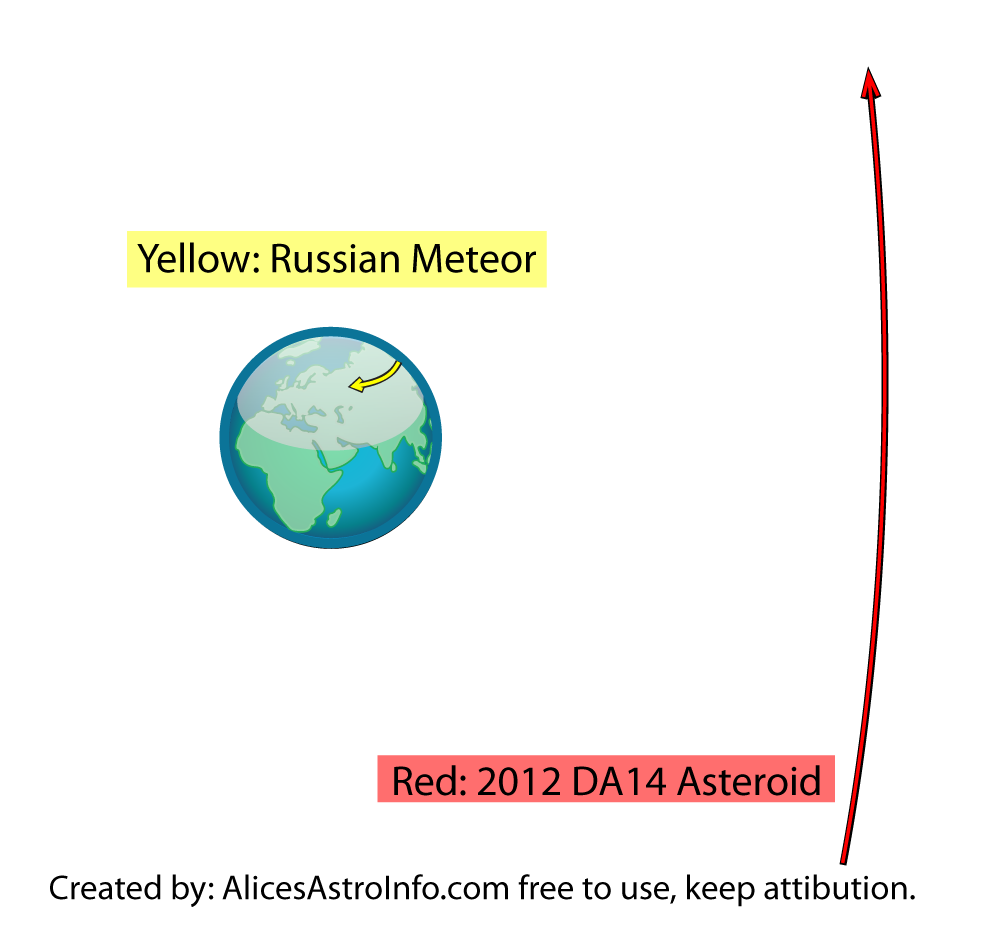
The distance between Earth and 2012 DA14 is approximately correct. The length of the meteor trail is NOT. *
I have tried to be as clear as I can when I created this diagram. The Russian Meteor and asteroid 2012 DA14 have COMPLETELY different paths. The directions are more-or-less correct in this diagram. The length of the meteor trail is too long, but the distance between the Earth and the asteroid is about correct.
This is why I strongly, STRONGLY think the two are unrelated. They’re just plain going different directions.
Okay. Basics:
- Last night (3:25am UTC 2/15/2013 or 7:25pm 2/14 Seattle) an awesome meteor streaked through the skies in Russia. People (numbers vary between 100-400) were injured because the sonic boom of the meteor broke glass and possibly some buildings.
So far (as of 1:34am Seattle time) there has been NO report of a meteor IMPACT. (So it’s a meteor not meteorite until confirmation).There are now likely true reports of impact. - The sonic boom set off car alarms as well.
- There is a spectacular trail in the sky behind the meteor. I, Alice, suspect this is mostly water vapor, just like clouds… but I haven’t done the chemistry on that yet. (Here’s tenuous corroboration.)
- The trail splits partway through suggesting the meteor did too. Not unusual: just cool.
- The earliest estimate, according to @Astro_Sailor on Twitter (a friend of an acquaintance) says in-back-of-the-envelope numbers that maybe this is within the realm of 300kg. I’m positive that number will change.
- New information: “The estimated size of the object, prior to entering Earth’s atmosphere, has been revised upward from 49 feet (15 meters) to 55 feet (17 meters), and its estimated mass has increased from 7,000 to 10,000 tons. Also, the estimate for energy released during the event has increased by 30 kilotons to nearly 500 kilotons of energy released. These new estimates were generated using new data that had been collected by five additional infrasound stations located around the world – the first recording of the event being in Alaska, over 6,500 kilometers away from Chelyabinsk. The infrasound data indicates that the event, from atmospheric entry to the meteor’s airborne disintegration took 32.5 seconds. The calculations using the infrasound data were performed by Peter Brown at the University of Western Ontario, Canada.” — Nasa.gov
- Not related to the asteroid. See diagram above/attached: mine is the best available.
- This is also not related to the comets this year.
- Yes, Russia got the world’s last cool meteor: the Tunguska Event in 1908.
Go read:
1) Phil Plait
3) Alan Boyle
We all make mistakes, but I trust them and they can help you weed out the real reports from the hoax reports. There are NO flaming craters, but it is an exciting event. Hoping everyone heals up from the falling glass okay.
* Thanks to @AstroGuyz I corrected a misspelling in the original diagram. That’s what I get for blogging at 2am!
![]()
~ A l i c e !
 Russian Meteor
Russian Meteor
Go read Phil’s post, because the best that I could do is quote him.
As far as I can tell it is UNRELATED to asteroid 2012 DA14 and the close approach tomorrow.
BE SKEPTICAL of anything you read. Phil says there are already hoaxes about this. I’ll write a second post as soon as I can pull together some real information for you.
![]()
~ A l i c e !
 Comet PanSTARRS
Comet PanSTARRS
It’s been a while since we had a good comet. Long enough that children in North America probably haven’t seen one, and you might have forgotten just how amazing they can be.
Comets Are Awesome
I know you don’t believe me, but comets can be spectacular objects to view without any magnification at all. No binoculars, no telescope, no squinting. This one might take a little magnification though, we’ll see. Comets are also unpredictable.
In 1996 Comet Huyakutake‘s tail spanned 100 degrees across the sky. Hold your arms at right angles to each other, then lift them up over your head, still at right angles. That’s 90 degrees. Look from one hand to the other- the tail was longer than the distance between your two hands (approximately). Now, Comet PanSTARRS (C/2011 L4) will probably not be like Huyakutake. All the evidence recently points to it being a bit of a dud, but it could still surprise us.
Comet Hale-Bopp (in 1997), which you likely remember had two tails, and under the best conditions that tail was about 10 degrees long. Hold your fist at arm’s length, and from knuckle to knuckle is about 10 degrees. The Moon is half a degree.
As of February 9th, PanSTARRS had a 2 degree gas and ion tail, visible in long-exposure photography from the Southern Hemisphere.
Can I See PanSTARRS?
This is what you all want to know, right? According to Sky and Telescope it is on track to being visible here in the northern hemisphere.
- When? March 12-24, 2013 is your best bet from the Northern Hemisphere (West Seattlites, this is you!). Look just after sunset. Lucky for us, West Seattle has a GREAT western horizon for stargazing. I’ll meet you at Lincoln Park, okay?
- Where? In the west, low on the horizon. Since it is just after sunset you won’t see many stars, but it is in the constellation Pisces in early March, and Andromeda in later March. Astronomy has a good finder chart.
- How? As of now, you’ll need binoculars. If it brightens up considerably you might not, but plan on bringing binoculars.
- What? Comet PanSTARRS currently has a 2 degree tail (two pinkie-finger widths), and should max out at a little brighter than the dimmer stars visible from the city of Seattle. With good viewing, the tail will be longer than the full Moon. If you can see the tail, observe how it is directed away from where the Sun just set.
- Is it close? We’re all about the close approaches right now. Comet PanSTARRS “will pass about 100 million miles from Earth as it briefly dips inside the orbit of Mercury.” according to NASA. That’s about the same as the distance from the Earth to the Sun. Not so close.
What Will It Look Like?
I found this image, and I like the context. This is more that you would see with your eyes. This is PanSTARRS on February 11 by Luis Argerich in Argentina (and a satellite on the right).
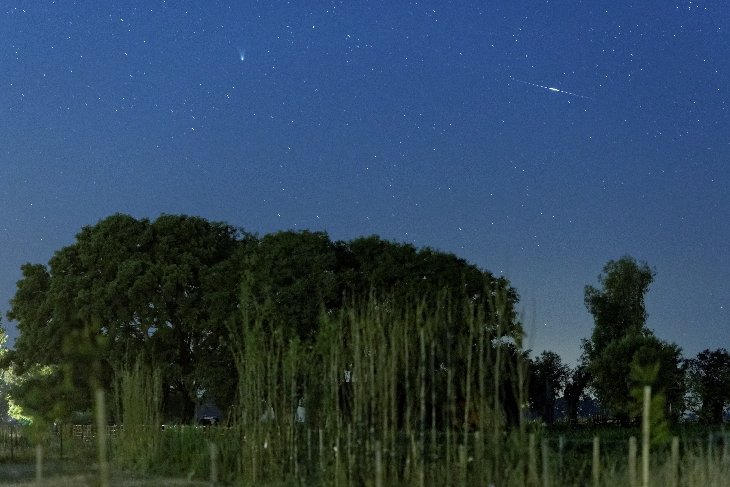
Comet PanSTARRS is the double-tailed smear on the left. The dotted line on the right is an Iridium satellite in this 10-second exposure.
Want More?
Sky and Telescope–great updated viewing information.
![]()
~ A l i c e !
 2012 DA14: Alice on KOMO Radio
2012 DA14: Alice on KOMO Radio
Quick link for you, KOMO’s Tom Hutyler and Jane Shannon interviewed me about the asteroid 2012 DA14 (close pass by the Earth on February 15 — no danger).
Hear it here: http://www.komonews.com/radio/home/featured/190111451.html
![]()
~ A l i c e !

